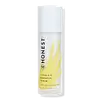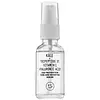What's inside
What's inside
 Key Ingredients
Key Ingredients

 Benefits
Benefits

 Concerns
Concerns

 Ingredients Side-by-side
Ingredients Side-by-side

Water
Skin ConditioningGlycerin
HumectantPropanediol
SolventPyrus Malus Fruit Extract
Skin ConditioningCynara Scolymus Leaf Extract
Skin ConditioningAloe Barbadensis Leaf Juice Powder
Skin ConditioningDiglucosyl Gallic Acid
Citric Acid
BufferingLysolecithin
EmulsifyingSclerotium Gum
Emulsion StabilisingXanthan Gum
EmulsifyingPullulan
Silica
AbrasiveSodium Acetylated Hyaluronate
HumectantSodium PCA
HumectantErythritol
HumectantCarrageenan
Hydrolyzed Sodium Hyaluronate
Skin ConditioningIsopentyldiol
HumectantTrifolium Pratense Flower Extract
AstringentCananga Odorata Flower Water
Skin ConditioningTrisodium Ethylenediamine Disuccinate
1,2-Hexanediol
Skin ConditioningCaprylhydroxamic Acid
Sodium Ascorbyl Phosphate
AntioxidantTin Oxide
AbrasiveBenzoic Acid
MaskingSorbic Acid
PreservativeSodium Hydroxide
BufferingPotassium Sorbate
PreservativeSodium Benzoate
MaskingCI 77891
Cosmetic ColorantMica
Cosmetic ColorantWater, Glycerin, Propanediol, Pyrus Malus Fruit Extract, Cynara Scolymus Leaf Extract, Aloe Barbadensis Leaf Juice Powder, Diglucosyl Gallic Acid, Citric Acid, Lysolecithin, Sclerotium Gum, Xanthan Gum, Pullulan, Silica, Sodium Acetylated Hyaluronate, Sodium PCA, Erythritol, Carrageenan, Hydrolyzed Sodium Hyaluronate, Isopentyldiol, Trifolium Pratense Flower Extract, Cananga Odorata Flower Water, Trisodium Ethylenediamine Disuccinate, 1,2-Hexanediol, Caprylhydroxamic Acid, Sodium Ascorbyl Phosphate, Tin Oxide, Benzoic Acid, Sorbic Acid, Sodium Hydroxide, Potassium Sorbate, Sodium Benzoate, CI 77891, Mica
Water
Skin ConditioningLactic Acid
BufferingCitric Acid
BufferingMalic Acid
BufferingGlycerin
HumectantPalmitoyl Tripeptide-5
Skin ConditioningMagnesium Ascorbyl Phosphate
AntioxidantButylene Glycol
HumectantBrassica Oleracea Acephala Leaf Extract
HumectantSpinacia Oleracea Leaf Extract
Skin ConditioningCamellia Sinensis Leaf Extract
AntimicrobialChamomilla Recutita Flower Extract
MaskingMedicago Sativa Leaf Extract
Skin ConditioningAloe Barbadensis Leaf Extract
EmollientSodium Hyaluronate Crosspolymer
HumectantPanthenol
Skin ConditioningHeptyl Glucoside
Hydroxyethylcellulose
Emulsion StabilisingSodium Hyaluronate
HumectantParfum
MaskingSuperoxide Dismutase
AntioxidantTyrosine
MaskingSodium Citrate
BufferingMagnesium Chloride
Pentylene Glycol
Skin ConditioningEthylhexylglycerin
Skin ConditioningPhenoxyethanol
PreservativePotassium Sorbate
PreservativeSodium Benzoate
MaskingWater, Lactic Acid, Citric Acid, Malic Acid, Glycerin, Palmitoyl Tripeptide-5, Magnesium Ascorbyl Phosphate, Butylene Glycol, Brassica Oleracea Acephala Leaf Extract, Spinacia Oleracea Leaf Extract, Camellia Sinensis Leaf Extract, Chamomilla Recutita Flower Extract, Medicago Sativa Leaf Extract, Aloe Barbadensis Leaf Extract, Sodium Hyaluronate Crosspolymer, Panthenol, Heptyl Glucoside, Hydroxyethylcellulose, Sodium Hyaluronate, Parfum, Superoxide Dismutase, Tyrosine, Sodium Citrate, Magnesium Chloride, Pentylene Glycol, Ethylhexylglycerin, Phenoxyethanol, Potassium Sorbate, Sodium Benzoate
 Reviews
Reviews

Ingredients Explained
These ingredients are found in both products.
Ingredients higher up in an ingredient list are typically present in a larger amount.
Citric Acid is an alpha hydroxy acid (AHA) naturally found in citrus fruits like oranges, lemons, and limes.
Like other AHAs, citric acid can exfoliate skin by breaking down the bonds that hold dead skin cells together. This helps reveal smoother and brighter skin underneath.
However, this exfoliating effect only happens at high concentrations (20%) which can be hard to find in cosmetic products.
Due to this, citric acid is usually included in small amounts as a pH adjuster. This helps keep products slightly more acidic and compatible with skin's natural pH.
In skincare formulas, citric acid can:
While it can provide some skin benefits, research shows lactic acid and glycolic acid are generally more effective and less irritating exfoliants.
Most citric acid used in skincare today is made by fermenting sugars (usually from molasses). This synthetic version is identical to the natural citrus form but easier to stabilize and use in formulations.
Read more about some other popular AHA's here:
Learn more about Citric AcidGlycerin is already naturally found in your skin. It helps moisturize and protect your skin.
A study from 2016 found glycerin to be more effective as a humectant than AHAs and hyaluronic acid.
As a humectant, it helps the skin stay hydrated by pulling moisture to your skin. The low molecular weight of glycerin allows it to pull moisture into the deeper layers of your skin.
Hydrated skin improves your skin barrier; Your skin barrier helps protect against irritants and bacteria.
Glycerin has also been found to have antimicrobial and antiviral properties. Due to these properties, glycerin is often used in wound and burn treatments.
In cosmetics, glycerin is usually derived from plants such as soybean or palm. However, it can also be sourced from animals, such as tallow or animal fat.
This ingredient is organic, colorless, odorless, and non-toxic.
Glycerin is the name for this ingredient in American English. British English uses Glycerol/Glycerine.
Learn more about GlycerinPotassium Sorbate is a preservative used to prevent yeast and mold in products. It is commonly found in both cosmetic and food products.
This ingredient comes from potassium salt derived from sorbic acid. Sorbic acid is a natural antibiotic and effective against fungus.
Both potassium sorbate and sorbic acid can be found in baked goods, cheeses, dried meats, dried fruit, ice cream, pickles, wine, yogurt, and more.
You'll often find this ingredient used with other preservatives.
Learn more about Potassium SorbateSodium Benzoate is a preservative. It's used in both cosmetic and food products to inhibit the growth of mold and bacteria. It is typically produced synthetically.
Both the US FDA and EU Health Committee have approved the use of sodium benzoate. In the US, levels of 0.1% (of the total product) are allowed.
Sodium benzoate works as a preservative by inhibiting the growth of bacteria inside of cells. It prevents the cell from fermenting a type of sugar using an enzyme called phosphofructokinase.
It is the salt of benzoic acid. Foods containing sodium benzoate include soda, salad dressings, condiments, fruit juices, wines, and snack foods.
Studies for using ascorbic acid and sodium benzoate in cosmetics are lacking, especially in skincare routines with multiple steps.
We always recommend speaking with a professional, such as a dermatologist, if you have any concerns.
Learn more about Sodium BenzoateWater. It's the most common cosmetic ingredient of all. You'll usually see it at the top of ingredient lists, meaning that it makes up the largest part of the product.
So why is it so popular? Water most often acts as a solvent - this means that it helps dissolve other ingredients into the formulation.
You'll also recognize water as that liquid we all need to stay alive. If you see this, drink a glass of water. Stay hydrated!
Learn more about Water